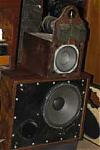
Originally Posted by
GordonW

I'm just wanting to be clear here- so, the bigger of those two spikes on the time response curve, is ALL THREE of the other drivers in the 4343 stacked up on top of each other, ie, the midrange horn, the midbass and the woofer? If so, that's pretty remarkable... that would very consistent response from drivers of different mechanical acoustic centers.
My suggestion, might be to seperate JUST the 2405 from the other three drivers- run a tri-amp setup- with the 2231/2235 woofer on one amp, the 10" midbass and mid horn on one amp, and the 2405 on a third amp. Then, use a digital time delay, to delay the 2405 .67ms. That shouldn't be too terribly hard- all you'd have to do, is seperate the 2405's crossover section from the rest, and just run another amp from a time delay unit for just that tweeter and crossover...



 Reply With Quote
Reply With Quote








